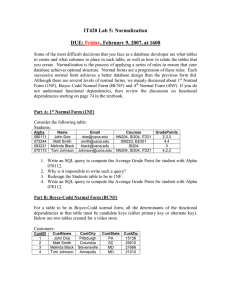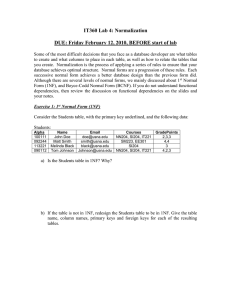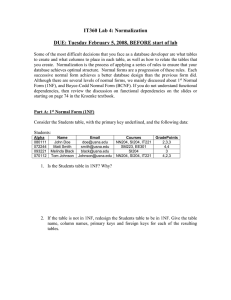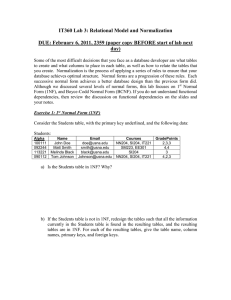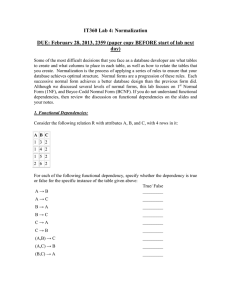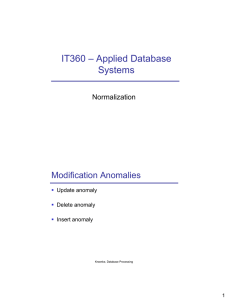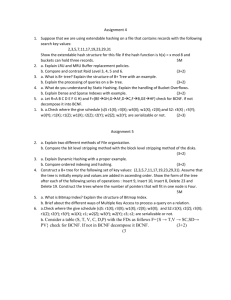IT420 Lab 5 Normalization
advertisement
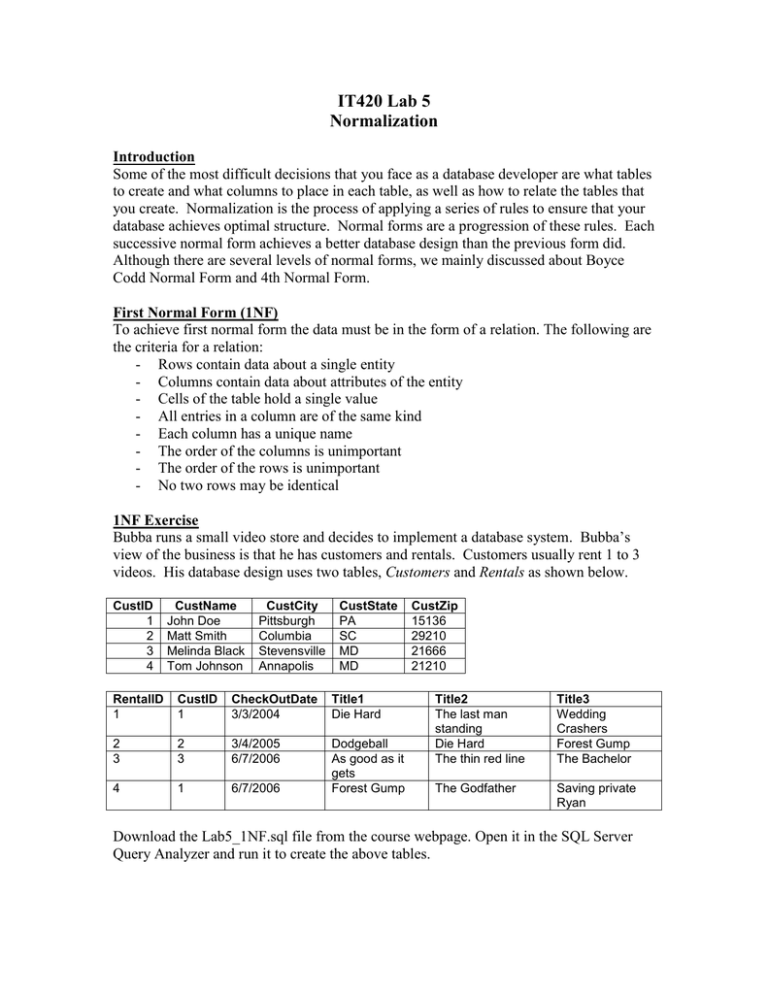
IT420 Lab 5 Normalization Introduction Some of the most difficult decisions that you face as a database developer are what tables to create and what columns to place in each table, as well as how to relate the tables that you create. Normalization is the process of applying a series of rules to ensure that your database achieves optimal structure. Normal forms are a progression of these rules. Each successive normal form achieves a better database design than the previous form did. Although there are several levels of normal forms, we mainly discussed about Boyce Codd Normal Form and 4th Normal Form. First Normal Form (1NF) To achieve first normal form the data must be in the form of a relation. The following are the criteria for a relation: - Rows contain data about a single entity - Columns contain data about attributes of the entity - Cells of the table hold a single value - All entries in a column are of the same kind - Each column has a unique name - The order of the columns is unimportant - The order of the rows is unimportant - No two rows may be identical 1NF Exercise Bubba runs a small video store and decides to implement a database system. Bubba’s view of the business is that he has customers and rentals. Customers usually rent 1 to 3 videos. His database design uses two tables, Customers and Rentals as shown below. CustID 1 2 3 4 CustName John Doe Matt Smith Melinda Black Tom Johnson CustCity Pittsburgh Columbia Stevensville Annapolis CustState PA SC MD MD RentalID 1 CustID 1 CheckOutDate 3/3/2004 Title1 Die Hard 2 3 2 3 3/4/2005 6/7/2006 4 1 6/7/2006 Dodgeball As good as it gets Forest Gump CustZip 15136 29210 21666 21210 Title2 The last man standing Die Hard The thin red line Title3 Wedding Crashers Forest Gump The Bachelor The Godfather Saving private Ryan Download the Lab5_1NF.sql file from the course webpage. Open it in the SQL Server Query Analyzer and run it to create the above tables. 1. Bubba wants to find all the customers who rented the ‘Die Hard’ movie in order to send them information about other Bruce Willis movies. Write an SQL query to list all customers who rented the ‘Die Hard’ movie. What makes this query cumbersome? Is it easy to determine how many times Die Hard was rented? 2. What do you do if a customer wants to rent 4 movies (or more)? 3. The difficulty with accomplishing these simple queries and tasks is the “Rentals” table is not in 1NF. Title1, Title2, and Title3 are unique names for column headings, but really describe the same thing: a “Movie”. Redesign the Rentals table (new name Rentals_2) so that it meets the criteria of 1NF with no repeating attributes. What is the primary key of the new table? 4. Write the SQL statement to create the Rentals_2 table in SQL Server. 5. Write SQL statements to insert all the data from Rentals table in the new Rentals_2 table. (remember bulk insert) 6. Re-write and rerun query 1. You will see that query1 is now easy to write and the problem with a customer renting a variable number of movies is eliminated. Boyce-Codd Normal Form (BCNF) To achieve Boyce-Codd normal form, all the determinants have to be candidate keys (either primary key or alternate key). (If you do not understand functional dependency then review functional dependency starting on page 74 in the textbook). Below are tables with a slight variation of the video store. The two tables meet 1NF requirements. Customers: CustID 1 2 3 4 CustName John Doe Matt Smith Melinda Black Tom Johnson CustCity Pittsburgh Columbia Stevensville Annapolis CustState PA SC MD MD CustZip 15136 29210 21666 21210 Rentals3 RentalID 1 1 1 2 2 3 4 Title Die Hard The last man standing Wedding Crashers Dodgeball CustID 1 1 CheckOutDate 3/3/2004 3/3/2004 Director John McTiernan Walter Hill ReleaseType Old Old Price $4.25 $4.25 1 3/3/2004 David Dobkin New $5.50 2 3/4/2005 New $5.50 Die Hard As good as it gets Forest Gump 2 3 3/4/2005 6/7/2006 Rawson Marshall Thurber John McTiernan James Brooks Old Old $4.25 $4.25 1 6/7/2006 Robert Zemeckis Old $4.25 The primary key in the Rentals3 table is the composite key (RentalID, Title). 7. Find the functional dependencies for Rentals3. 8. Is Rentals3 in BCNF? The answer is No, but you should justify it. 9. What problems are manifested by not having the tables in BCNF? The text discusses insertion anomalies, deletion anomalies and modification anomalies. Give one example of each of these anomalies in the above table. 10. Decompose the Rentals3 table into BCNF. 4NF Suppose we have the following Courses table with columns Course, Teacher, Book. The meaning of a row (C, T, B) in the table is that teacher T can teach course C and B is a recommended book for course C. The recommended book is independent of teacher. Here is an example of instantiation for this table: Course IT420 IT420 IT420 IT420 SI440 SI440 SI440 Teacher Crainiceanu Crainiceanu McKenna McKenna Crainiceanu Crainiceanu Crainiceanu Book Kroenke Ramakrishnan Kroenke Ramakrishnan Kroenke Ramakrishnan Stonebraker 11. What is a multivalue dependency? 12. Is the above table in 4th normal form? 13. If answer to 12 is yes, say why. If not, transform the table to be in 4th normal form. Normalization: yes or no? 14. Assuming that city and state determine zip code, is Customers table in BCNF? 15. If Customers table is not in BCNF, would you or would you not normalize it to BCNF? Give at least one reason for the choice you make. Lab Submission: This Lab will not be submitted for a grade but must be completed.
